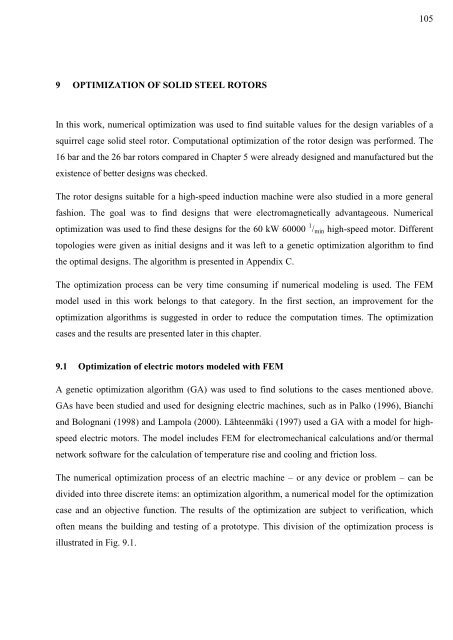Design and Voltage Supply of High-Speed Induction - Aaltodoc
Design and Voltage Supply of High-Speed Induction - Aaltodoc
Design and Voltage Supply of High-Speed Induction - Aaltodoc
Create successful ePaper yourself
Turn your PDF publications into a flip-book with our unique Google optimized e-Paper software.
9 OPTIMIZATION OF SOLID STEEL ROTORS<br />
In this work, numerical optimization was used to find suitable values for the design variables <strong>of</strong> a<br />
squirrel cage solid steel rotor. Computational optimization <strong>of</strong> the rotor design was performed. The<br />
16 bar <strong>and</strong> the 26 bar rotors compared in Chapter 5 were already designed <strong>and</strong> manufactured but the<br />
existence <strong>of</strong> better designs was checked.<br />
The rotor designs suitable for a high-speed induction machine were also studied in a more general<br />
fashion. The goal was to find designs that were electromagnetically advantageous. Numerical<br />
optimization was used to find these designs for the 60 kW 60000 1 /min high-speed motor. Different<br />
topologies were given as initial designs <strong>and</strong> it was left to a genetic optimization algorithm to find<br />
the optimal designs. The algorithm is presented in Appendix C.<br />
The optimization process can be very time consuming if numerical modeling is used. The FEM<br />
model used in this work belongs to that category. In the first section, an improvement for the<br />
optimization algorithms is suggested in order to reduce the computation times. The optimization<br />
cases <strong>and</strong> the results are presented later in this chapter.<br />
9.1 Optimization <strong>of</strong> electric motors modeled with FEM<br />
A genetic optimization algorithm (GA) was used to find solutions to the cases mentioned above.<br />
GAs have been studied <strong>and</strong> used for designing electric machines, such as in Palko (1996), Bianchi<br />
<strong>and</strong> Bolognani (1998) <strong>and</strong> Lampola (2000). Lähteenmäki (1997) used a GA with a model for highspeed<br />
electric motors. The model includes FEM for electromechanical calculations <strong>and</strong>/or thermal<br />
network s<strong>of</strong>tware for the calculation <strong>of</strong> temperature rise <strong>and</strong> cooling <strong>and</strong> friction loss.<br />
The numerical optimization process <strong>of</strong> an electric machine – or any device or problem – can be<br />
divided into three discrete items: an optimization algorithm, a numerical model for the optimization<br />
case <strong>and</strong> an objective function. The results <strong>of</strong> the optimization are subject to verification, which<br />
<strong>of</strong>ten means the building <strong>and</strong> testing <strong>of</strong> a prototype. This division <strong>of</strong> the optimization process is<br />
illustrated in Fig. 9.1.<br />
105
















